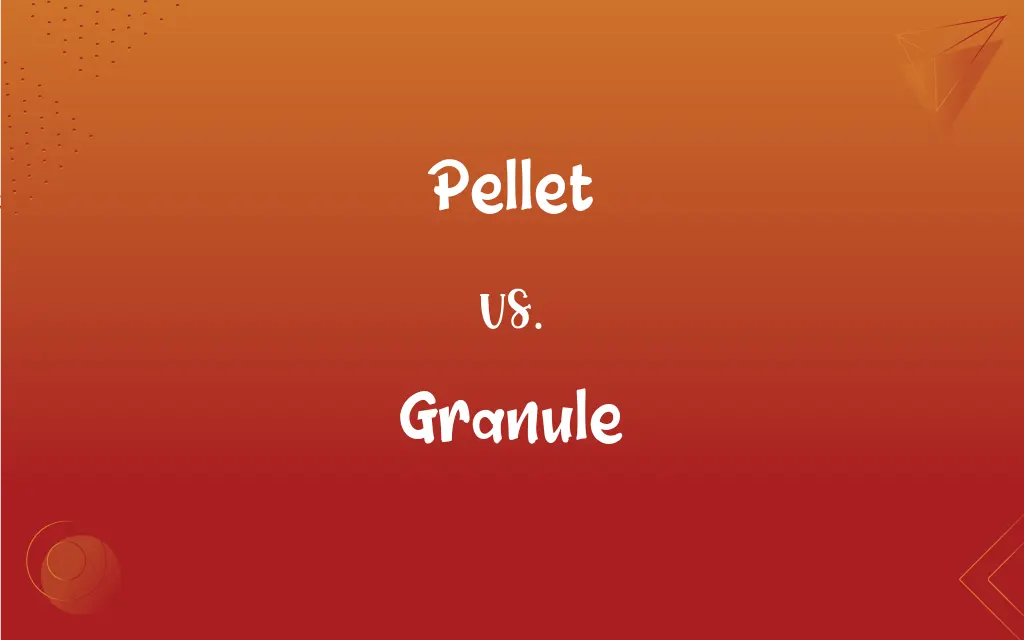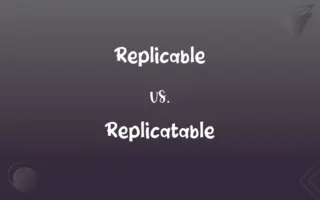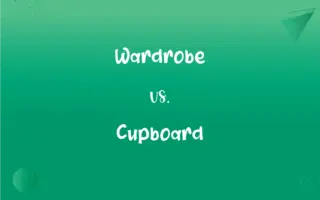Pellet vs. Granule: What's the Difference?
Edited by Harlon Moss || By Janet White || Updated on October 5, 2023
A pellet is a small, rounded, compressed mass, often uniform in shape. A granule is a small particle or grain, usually irregular in shape.

Key Differences
Pellet and granule are terms often used to describe small solid objects, but they have distinct characteristics. A pellet typically refers to a small, rounded, often compressed mass. These can be manufactured or naturally occurring and are often uniform in their structure. On the other hand, a granule refers to a small particle or grain. Granules can be coarse or fine, but they are generally not as uniformly shaped as pellets.
Both pellets and granules find usage in various industries. For instance, in the pharmaceutical sector, pellets are often designed to release drugs over a prolonged period. Granules, meanwhile, might be used as intermediates in the production of tablets. Another industry where the distinction is clear is in animal feed. Here, pellets often refer to compressed feed shaped into small cylindrical or spherical forms, while granules might refer to smaller, often irregular pieces of feed.
The process of forming both pellets and granules can be different. Pelleting often involves compression, molding, or extrusion, resulting in a more uniform shape. Granulation, on the other hand, might involve processes like drying or agglomeration, leading to more irregularly shaped particles.
In everyday use, the distinction between pellets and granules might not always be strict. However, in technical or industrial contexts, their differences become essential. While both are small in size, their shape, formation process, and application can vary significantly.
Comparison Chart
Definition
A small, rounded, compressed mass.
A small particle or grain.
ADVERTISEMENT
Shape
Typically uniform (e.g., spherical, cylindrical).
Usually irregular.
Formation Process
Compression, molding, extrusion.
Drying, agglomeration.
Usage in Pharmaceuticals
Designed for prolonged drug release.
Used as intermediates in tablet production.
Common Applications
Animal feed, pharmaceuticals, air gun ammunition.
Sand granules, sugar granules, pharmaceuticals.
Pellet and Granule Definitions
Pellet
A small compressed mass of a substance.
He fed the fish with tiny pellets.
ADVERTISEMENT
Granule
A small pill or dosage form in medicine.
The doctor prescribed the medicine in granule form for easier ingestion.
Pellet
A compressed food item for animals.
The farmer gave the chickens feed pellets.
Granule
A tiny portion of a substance, usually in particle form.
There were granules of sand in her shoes after the beach visit.
Pellet
A small cylindrical or spherical sample of a substance.
The scientist examined the iron pellets under a microscope.
Granule
A small, loose particle or grain.
Sugar granules were scattered on the countertop.
Pellet
A lead or other metal projectile designed for shooting.
He loaded the air rifle with pellets.
Granule
A crystalline particle.
The scientist examined the granules under the microscope.
Pellet
A solid used in reactors, typically of a specific material like uranium.
The reactor uses uranium pellets as fuel.
Granule
A cellular or structural particle in biological contexts.
The cytoplasm of the cell contains various granules.
Pellet
A small, solid or densely packed ball or mass, as of food, wax, or medicine.
Granule
A small grain or pellet; a particle.
Pellet
A bullet or piece of small shot.
Granule
(Geology) A rock or mineral fragment larger than a sand grain and smaller than a pebble, between 2 and 4 millimeters in diameter.
Pellet
A stone ball, used as a catapult missile or a primitive cannonball.
Granule
(Astronomy) One of the small, transient, luminous markings in the photosphere of the sun.
Pellet
To make or form into pellets.
Granule
(Biology) A cellular or cytoplasmic particle, especially one that stains readily.
Pellet
To strike with pellets.
Granule
A tiny grain, a small particle.
Pellet
A small, compressed, hard chunk of matter.
A pellet of wood, paper, or ore
Granule
(biology) A small structure in a cell.
Pellet
A lead projectile used as ammunition in rifled air guns.
Granule
(geology) A particle from 2 to 4 mm in diameter, following the Wentworth scale
Pellet
Compressed byproduct of digestion regurgitated by owls and many other birds of prey, which serves as a waste disposal mechanism for indigestible parts of food, such as fur and bones.
Granule
(astronomy) a small mark in the photosphere of the sun caused by convection currents. See also Wikipedia:Granule (solar physics).
Pellet
(heraldry) A roundel sable (black circular spot).
Granule
A little grain; a small particle; a pellet.
Pellet
One of the short conductive tubes in a Pelletron particle accelerator.
Granule
A tiny grain
Pellet
To form into pellets.
Pellet
To strike with pellets.
Pellet
A little ball; as, a pellet of wax on paper.
Pellet
A bullet; a ball for firearms.
As swift as a pellet out of a gun.
Pellet
To form into small balls; to pelletize.
Pellet
A small sphere
Pellet
A solid missile discharged from a firearm;
The shot buzzed past his ear
FAQs
Can granules be seen with the naked eye?
Yes, granules are typically large enough to be seen without magnification, like grains of sand or sugar.
How is a granule different from a pellet?
A granule is a small particle or grain, typically irregular in shape, unlike the more uniform pellet.
Are pellets used in medicines?
Yes, certain medicines are formulated as pellets for controlled drug release.
What is a pellet in simple terms?
A pellet is a small, rounded, compressed mass, often uniform in shape.
Can granules be made intentionally, or are they always natural?
Granules can be intentionally manufactured or occur naturally.
Are pellets always made by compressing material?
While many pellets are made by compression, they can also be formed through molding or extrusion.
Are all pellets round in shape?
While many pellets are round, they can also be cylindrical or other shapes.
What's an example of a pellet in daily life?
A common example is the compressed feed given to pet fish.
Are pellets used in air guns?
Yes, air guns typically fire metal pellets.
Are granules used in any food items?
Yes, granulated sugar is a prime example.
How are pellets formed in the animal feed industry?
They're often formed by compressing feed ingredients into small cylindrical or spherical shapes.
Can the word "pellet" be used in a metaphorical sense?
Yes, like "a pellet of wisdom" implying a small but significant piece of knowledge.
Do granules have applications in the pharmaceutical industry?
Absolutely, granules are often intermediates in tablet production.
Are granules always solid?
Typically, yes. Granules refer to solid particles.
Can granules be of different sizes?
Absolutely, granules can range from very fine to coarse.
How might granules appear in a biology context?
In biology, granules can refer to cellular or structural particles within cells.
Are pellets and granules only relevant in English?
No, similar concepts exist in other languages, but the terms and nuances might differ.
How about a granule example from everyday life?
Sugar granules in your kitchen are a perfect example.
Can a pellet be considered a type of granule?
Not technically. While both are small, a pellet is usually more uniformly shaped, while a granule is more irregular.
Are wood pellets a type of pellet?
Yes, wood pellets are compressed sawdust used for heating.
About Author
Written by
Janet WhiteJanet White has been an esteemed writer and blogger for Difference Wiki. Holding a Master's degree in Science and Medical Journalism from the prestigious Boston University, she has consistently demonstrated her expertise and passion for her field. When she's not immersed in her work, Janet relishes her time exercising, delving into a good book, and cherishing moments with friends and family.
Edited by
Harlon MossHarlon is a seasoned quality moderator and accomplished content writer for Difference Wiki. An alumnus of the prestigious University of California, he earned his degree in Computer Science. Leveraging his academic background, Harlon brings a meticulous and informed perspective to his work, ensuring content accuracy and excellence.































































